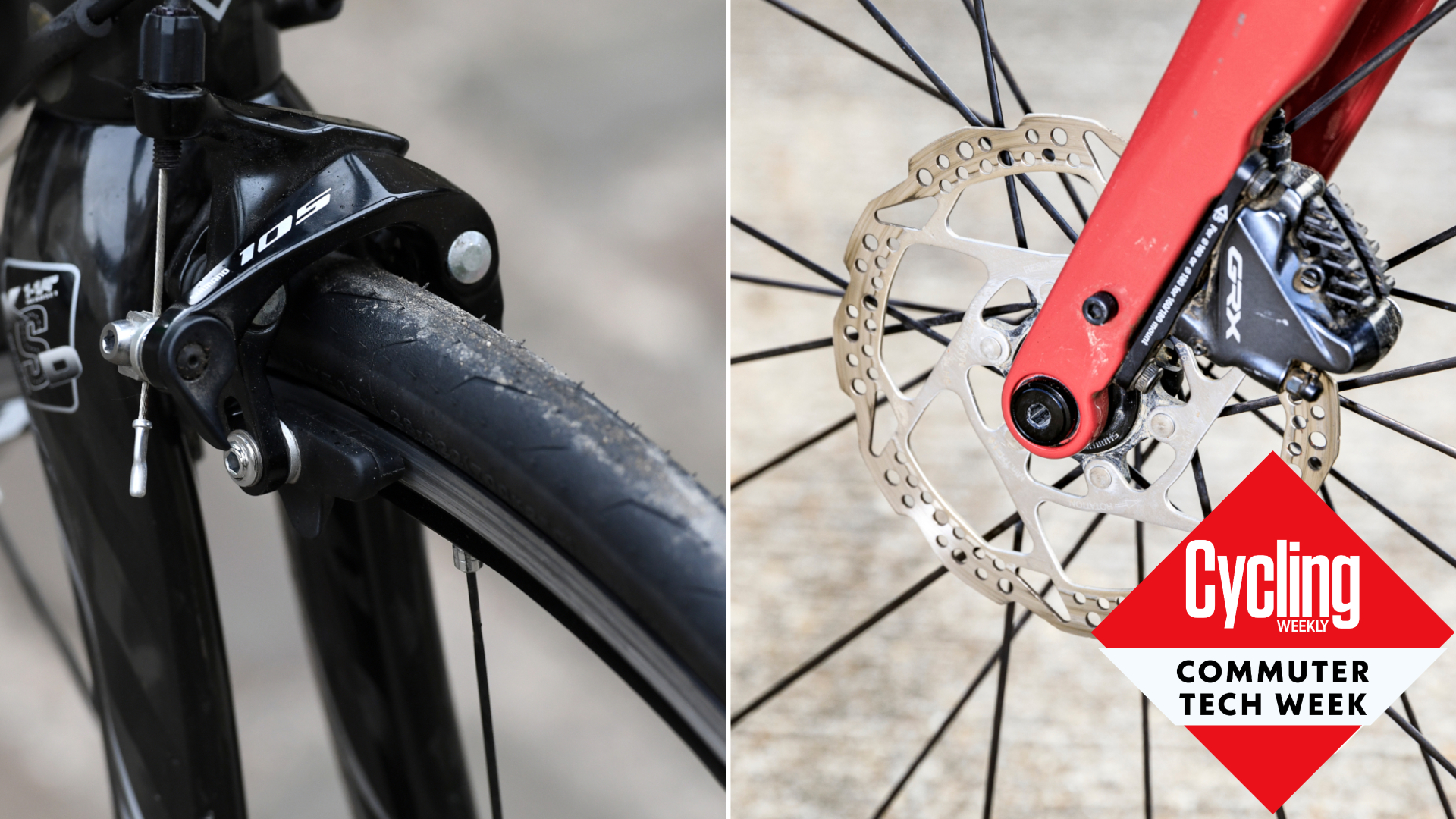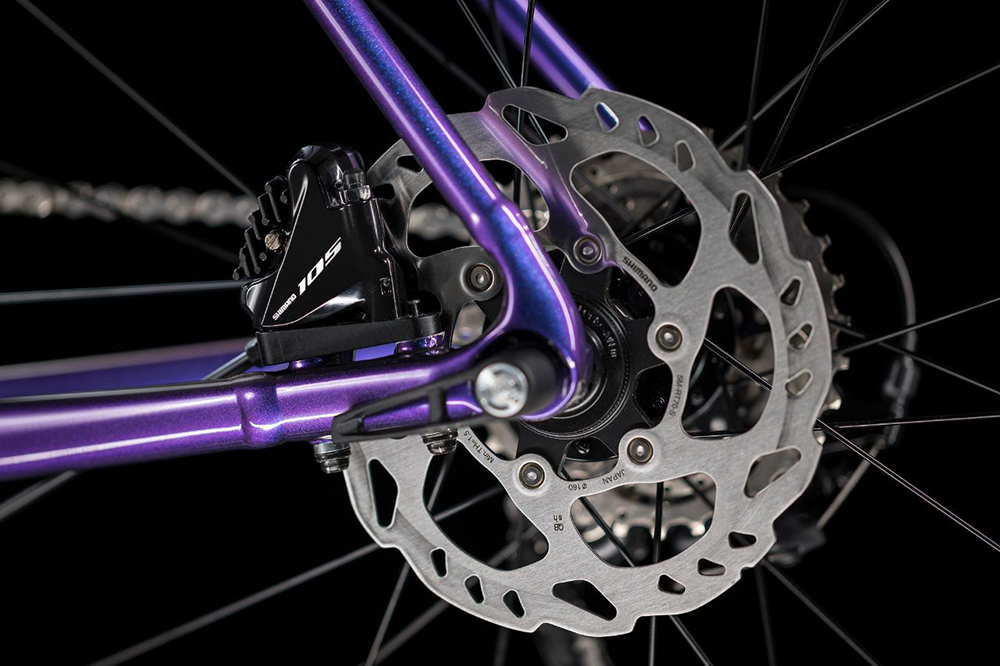Disc or rim brakes for commuting: what to choose
Are rim brakes or disc brakes the best choice for your bike as you commute to work? We run through the pros and cons of both, leaving you more knowledgable to make a decision

Reliable brakes are essential on any bike. Having the ability to stop when you need to is a prerequisite for any safe ride - especially on your journey to and from work when weaving through traffic.
Here we'll guide you through what brakes to look for in a bike for commuting, whether you're buying new and you've got your eye on one of the best commuter bikes, hunting out the best deal for you and your riding needs when buying a used bike, or considering upgrading the brakes on your current commuter.
Brake styles
Rim brakes
Rim brakes work by using your wheel’s rim as the braking surface. There are a number of different caliper styles available but all use brake pads, that attach to the caliper.
The caliper connects to the brake lever via a cable. Pull the lever and the tension added to the cable will pull the caliper arms towards each other, eventually ensuring that the pads meet the rim. If set up correctly your bike should slow down and come to a stop.
Modern road bikes specced with rim brakes use a dual pivot caliper. A hybrid bike with rim brakes will instead use linear pull brakes, better known as V-brakes. Unlike road calipers that mount centrally to the frame, V-brakes mount to the forks and the seat stays. Similarly cantilever brakes mount in the same way and are common on cyclocross bikes and touring bikes of a certain vintage.
Disc brakes
The latest race content, interviews, features, reviews and expert buying guides, direct to your inbox!
Disc brakes are becoming almost ubiquitous on all modern bikes. In simple terms, disc brakes move the braking surface from the wheel rim to a specially-designed disc or rotor attached to the hub of each wheel.
The calipers mount on the fork and on the chainstay. Actuating the brake moves a piston in the caliper that pushes the pad or pads onto the rotor. Disc brakes can be both cable-actuated, like rim brakes, or hydraulic in their operation. There are a range of brake pads from different brands and we've got a comprehensive review of the best brake pads here.
Framing your limitations
If you want to upgrade your current commuter bike’s brakes you’ll need to take into consideration a couple of points.
Your bike frame is designed around a particular style of brakes. Thus, a switch to another style might not be possible. How the brake calipers mount to the frame depends on the style of brake.
V-brakes require a frame with special mounts or ‘bosses’ on the fork and seat stays. Likewise a road bike frame using dual pivot calipers has specially drilled holes in the fork crown and in the seat stay bridge to allow them to be mounted correctly. This set up indicates that the road bike's frame won’t have the necessary mounts for a V-brake caliper and vice versa.
Disc brake standards
Disc brakes also require a compatible frame, and how the calipers mount to the frame and forks has evolved over the years. Rather than one ‘standard’ disc brakes fall into three categories: I.S mount, post mount and flat mount:
- I.S mount: Standing for International Standard, this mount attaches the caliper to the frame and forks with two bolts that are 51mm apart. Ironically, it is no longer standard;
- Post mount calipers fit onto threaded ‘post’ mounts on the frame and fork. The bolts run through the caliper, allowing for easier adjustment when setting up your disc brakes;
- Flat mount is the newer standard and the one you’ll most likely see on the latest disc road and gravel bikes. Here, the front caliper mounts to an adapter and then bolts to two threaded inserts on the fork. The rear caliper eschews the adapter and instead uses two bolts that run through a ‘flat’ surface on the frame before threading into the caliper body.
Fortunately there are adapters available to allow you to fit some post mount calipers on flat mount frames. The reverse isn’t generally possible.
Is the rim brake dead?
No, not just yet. Rim brakes have worked, and continue to work, really well across a range of uses. There's a reason why they have been the mainstay of recreational and professional cycling, powering the likes of Eddy Merckx, Greg Lemond and Chris Froome safely down wet alpine passes at death-defying speeds, and a 9-5 worker safely home from work.

But disc brakes are an undeniably more effective way of braking. More importantly they’re more reliable in adverse weather conditions. This is where, as a commuter, you may see a real advantage. Unless you only ride to work when the sun is shining, you’ll benefit from the confidence that disc brakes give you in the wet.
So who might still benefit from rim brakes?
If you are that fair weather communuter then v-brakes on a flat bar hybrid could still work really well for you. Add in the fact that you like to do your own maintenance and the relative ease of setting up a v-brake, replacing the brake cable and installing new rim brake pads might tip the scales.
If you’re already riding a bike fitted with rim brakes to work, a little maintenance goes a long way. You should regularly check the pads for wear (most pads have a wear line) as well for any sharp items that may have become embedded in the pad.
You also need to check regularly that the brake cables are running smoothly and with as little friction as possible. Finally, check the wheel rim for wear. Remember this is the braking surface and it won’t last forever. If your rim feels concave to the touch, then it’s time to replace it.
Sold on discs?
If you’re shopping for a new commuter and you’ve decided on disc brakes, you'll need to make another choice: cable or hydraulic.
As we touched on earlier, cable-operated or 'mechanical' disc brakes use a standard brake lever and cable in the same way a rim brake does. The majority of cable disc brakes use a fixed pad and moving pad to stop the rotor. In short, the moving pad flexes and then traps the rotor between the two pads. However, the popular TRP Spyre disc calipers move both pads in unison, exactly how hydraulic disc brakes also work.
Hydros use fluid that is stored in a reservoir in the brake lever instead of a cable. Pull the lever and the fluid is transferred to the caliper via the brake hose. The fluid then pushes the pistons out simultaneously, moving the attached brake pads against the rotor.
Typically, cable disc brakes for road bikes are easier to look after and are significantly cheaper to buy.

But which works best?
On pure braking alone control, hydraulic disc brakes are unbeatable. They deliver better brake feel at the lever end and with far less effort. This superior brake modulation has won many a convert and will continue to do so.
Another benefit of hydros is that they are self-adjusting. Unlike cable disc brakes, where you will need to compensate for pad wear by adjusting cable attention, hydraulic brakes do this automatically.
Mechanical disc brakes rely on a cable, and thus are susceptible to the same braking issues as rim brakes - namely, the build up of friction in the cable, happening gradually over time. The dirt from your wet commutes will also contribute and eventually the brake will feel spongy, not something that you want from any brake, especially a disc brake.
Of course, this can be mitigated somewhat by regular maintenance, and you can even fit compressionless brake housing. But ultimately it's hard for a cable disc brake to match the feel that a hydro delivers.

So why would I consider cable-operated disc brakes?
If this doesn't seem like a fair fight, we're about to re-address the balance. At least a little.
In the same way that we suggested v-brakes to those who like to do a little of their own bike maintenance, cable discs offer this option, too.
Like v-brakes, they are straightforward to troubleshoot. Once you've figured out the issue, they are also pretty easy to adjust and maintain. Replacing the pads and the cable is something that almost anyone can do with a little practice.
Follow the set-up instructions and dialing them in isn't so hard, either. If your commute is long and you like the idea of being self-sufficient, then cable disc brakes put you in charge. Select a robust, hand-machined caliper like the easily serviceable Paul Components Klamper and with the proper care you might just have a brake set for life.
On the contrary, hydros require far less general maintenance. It's a sealed system, which makes it less likely to suffer from contamination. But this also means that when there is an issue it's harder to fix without the help of a bike shop.
Not everyone wants to tackle bleeding their brakes at home. And if your brakes stop working on your ride to the office, you can't just whip out a spare cable to solve the issue.
Some disc brake TLC
Frequent commuting can be hard on your disc brakes so check them often and respond to a perceptible change in your bike's braking.
Regardless of whether you opt for cable or hydro disc brakes, you'll need to keep the rotors free from oil and other contaminants. Likewise, disc pads also need to be kept clean. If they are beyond help, it's best to replace them. Worn? Swap them.
It's worth remembering that new pads require a little bedding in. This is a process of transference of material from brake pad to rotor that greatly improves the quality of the brake.
Once you've picked up your new commuter bike, or have just replaced the pads on your existing ride, ensure to take time to bed-in the pads. Experiencing vibration and brake squeal? That will be the pads.
To bed-in your disc brakes build up a bit of speed and then apply the brakes. Make sure you don't skid or come to halt - you just want to slow the bike to a walking pace. Then, release the brakes while you're still rolling and repeat. Do this around 10-20 times and you should notice improvement with each repetition.
Luke Friend has worked as a writer, editor and copywriter for over twenty five years. Across books, magazines and websites, he's covered a broad range of topics for a range of clients including Major League Baseball, Golf Digest, the National Trust and the NHS. He has an MA in Professional Writing from Falmouth University and is a qualified bicycle mechanic. He has been a cycling enthusiast from an early age, partly due to watching the Tour de France on TV. He's a keen follower of bike racing to this day as well as a regular road and gravel rider.